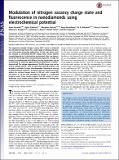| dc.contributor.author | Peterka, Darcy S. | |
| dc.contributor.author | Owen, Jonathan S. | |
| dc.contributor.author | Yuste, Rafael | |
| dc.contributor.author | Karaveli, Sinan | |
| dc.contributor.author | Gaathon, Ophir | |
| dc.contributor.author | Wolcott, Abraham | |
| dc.contributor.author | Sakakibara, Reyu | |
| dc.contributor.author | Shemesh, Or | |
| dc.contributor.author | Boyden, Edward | |
| dc.contributor.author | Englund, Dirk R. | |
| dc.date.accessioned | 2017-05-24T12:50:28Z | |
| dc.date.available | 2017-05-24T12:50:28Z | |
| dc.date.issued | 2016-03 | |
| dc.date.submitted | 2016-02 | |
| dc.identifier.issn | 0027-8424 | |
| dc.identifier.issn | 1091-6490 | |
| dc.identifier.uri | http://hdl.handle.net/1721.1/109302 | |
| dc.description.abstract | The negatively charged nitrogen vacancy (NV⁻) center in diamond has attracted strong interest for a wide range of sensing and quantum information processing applications. To this end, recent work has focused on controlling the NV charge state, whose stability strongly depends on its electrostatic environment. Here, we demonstrate that the charge state and fluorescence dynamics of single NV centers in nanodiamonds with different surface terminations can be controlled by an externally applied potential difference in an electrochemical cell. The voltage dependence of the NV charge state can be used to stabilize the NV⁻ state for spin-based sensing protocols and provides a method of charge state-dependent fluorescence sensing of electrochemical potentials. We detect clear NV fluorescence modulation for voltage changes down to 100 mV, with a single NV and down to 20 mV with multiple NV centers in a wide-field imaging mode. These results suggest that NV centers in nanodiamonds could enable parallel optical detection of biologically relevant electrochemical potentials. | en_US |
| dc.description.sponsorship | United States. Army Research Office (W911NF-12-1-0594) | en_US |
| dc.description.sponsorship | United States. National Institutes of Health (1R01NS087950) | en_US |
| dc.description.sponsorship | United States. Defense Advanced Research Projects Agency (D14PC00121) | en_US |
| dc.description.sponsorship | United States. Defense Advanced Research Projects Agency (HR0011-14-C-0018) | en_US |
| dc.description.sponsorship | United States. National Institutes of Health (1R43MH102942-01) | en_US |
| dc.description.sponsorship | National Science Foundation (U.S.) (1122374) | en_US |
| dc.language.iso | en_US | |
| dc.publisher | National Academy of Sciences (U.S.) | en_US |
| dc.relation.isversionof | http://dx.doi.org/10.1073/pnas.1504451113 | en_US |
| dc.rights | Article is made available in accordance with the publisher's policy and may be subject to US copyright law. Please refer to the publisher's site for terms of use. | en_US |
| dc.source | PNAS | en_US |
| dc.title | Modulation of nitrogen vacancy charge state and fluorescence in nanodiamonds using electrochemical potential | en_US |
| dc.type | Article | en_US |
| dc.identifier.citation | Karaveli, Sinan; Gaathon, Ophir; Wolcott, Abraham; Sakakibara, Reyu; Shemesh, Or A.; Peterka, Darcy S.; Boyden, Edward S.; Owen, Jonathan S.; Yuste, Rafael and Englund, Dirk. “Modulation of Nitrogen Vacancy Charge State and Fluorescence in Nanodiamonds Using Electrochemical Potential.” Proceedings of the National Academy of Sciences 113, no. 15 (March 2016): 3938–3943 © 2016 National Academy of Sciences | en_US |
| dc.contributor.department | Massachusetts Institute of Technology. Department of Biological Engineering | en_US |
| dc.contributor.department | Massachusetts Institute of Technology. Department of Brain and Cognitive Sciences | en_US |
| dc.contributor.department | Massachusetts Institute of Technology. Department of Electrical Engineering and Computer Science | en_US |
| dc.contributor.department | Massachusetts Institute of Technology. Media Laboratory | en_US |
| dc.contributor.department | McGovern Institute for Brain Research at MIT | en_US |
| dc.contributor.mitauthor | Karaveli, Sinan | |
| dc.contributor.mitauthor | Gaathon, Ophir | |
| dc.contributor.mitauthor | Wolcott, Abraham | |
| dc.contributor.mitauthor | Sakakibara, Reyu | |
| dc.contributor.mitauthor | Shemesh, Or | |
| dc.contributor.mitauthor | Boyden, Edward | |
| dc.contributor.mitauthor | Englund, Dirk R. | |
| dc.relation.journal | Proceedings of the National Academy of Sciences | en_US |
| dc.eprint.version | Final published version | en_US |
| dc.type.uri | http://purl.org/eprint/type/JournalArticle | en_US |
| eprint.status | http://purl.org/eprint/status/PeerReviewed | en_US |
| dspace.orderedauthors | Karaveli, Sinan; Gaathon, Ophir; Wolcott, Abraham; Sakakibara, Reyu; Shemesh, Or A.; Peterka, Darcy S.; Boyden, Edward S.; Owen, Jonathan S.; Yuste, Rafael; Englund, Dirk | en_US |
| dspace.embargo.terms | N | en_US |
| dc.identifier.orcid | https://orcid.org/0000-0003-0687-6735 | |
| dc.identifier.orcid | https://orcid.org/0000-0001-8673-7094 | |
| dc.identifier.orcid | https://orcid.org/0000-0001-5357-3134 | |
| dc.identifier.orcid | https://orcid.org/0000-0002-8004-9271 | |
| dc.identifier.orcid | https://orcid.org/0000-0002-0419-3351 | |
| mit.license | PUBLISHER_POLICY | en_US |
